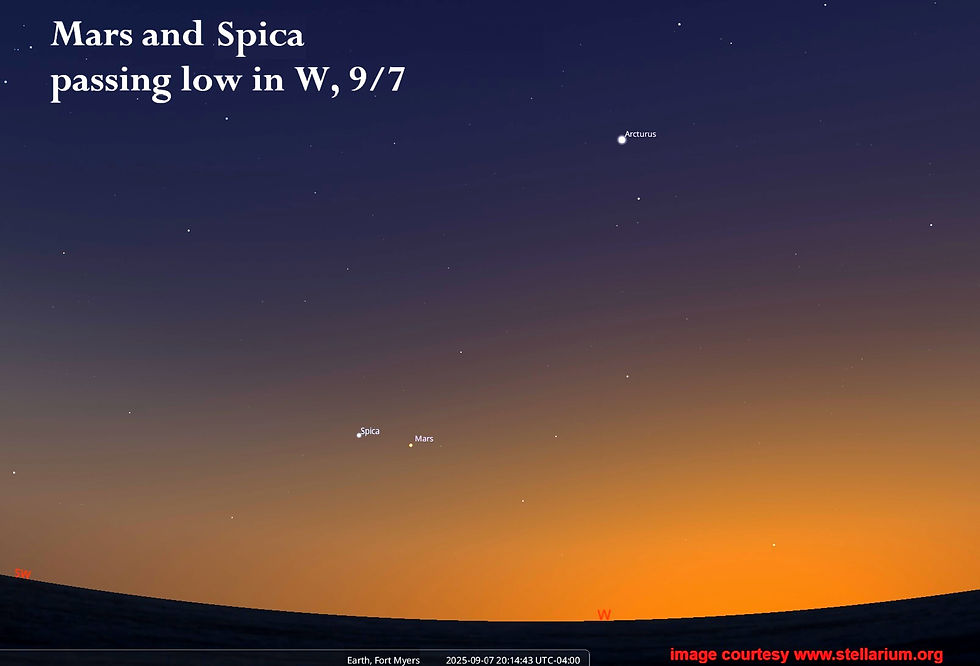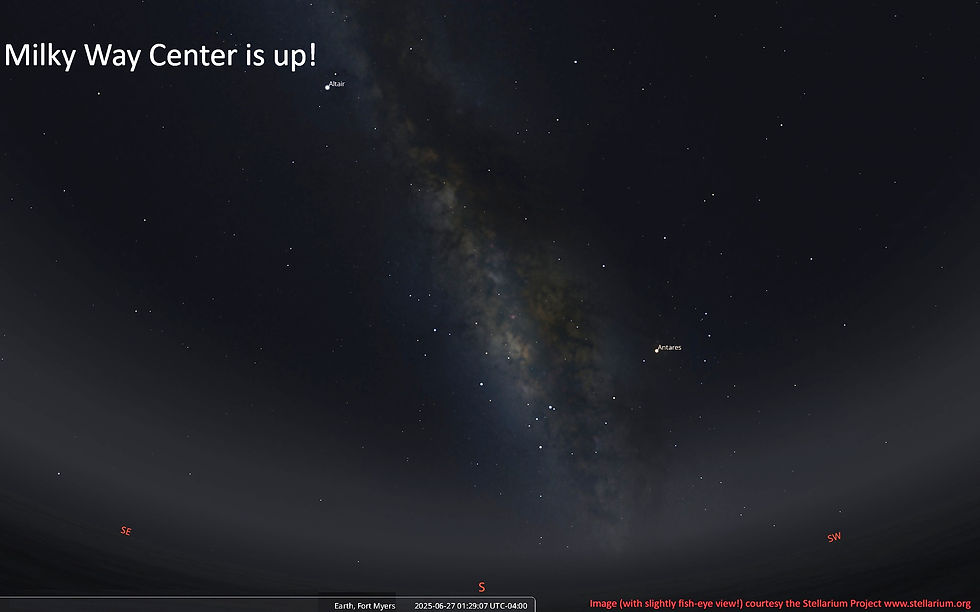What's Up in SW FL Skies: August is the Perseid Meteor Shower -- also Planets and Constellations this month
- heather92475
- Aug 10, 2024
- 4 min read
Moon Phases Aug 2024 (EDT)
New 1stQuarter Full 3rd Quarter
4 12 19 26
Planets: Sunset, Night and Dawn
Venus and Mercury are early evening planets at the start of the month, but remember, Mercury is fast! This means right after sunset (say, 8:45 pm) on August 1, there are two planets visible: Venus is the bright one low in the WNW, Mercury is dimmer and a little higher, to the left of Venus as you face west. Mercury is plunging toward the Sun from our point of view night by night, so it is even with Venus by the 3rd, below it thereafter, and by the 8th we won't even be able to see it as it gets too close to the Sun from our point of view. Venus will still be quite bright and seemingly getting brighter all month - also it appears a little farther south each night, and since the Sun is setting earlier each evening, by August 31, brilliant Venus will dominate the lower western sky by 8 pm, slightly south of west. Around the 21st, Mercury will reappear in the eastern pre-dawn sky, very low before sunrise and just slightly north of west.
At the beginning of the month, the planet Saturn rises (look eastward) around 10:30 pm, but that will be earlier each night, so that by month's end, Saturn is already above the eastern horizon once it's fully dark out.
Before dawn (6 am, say) at the start of the month, Jupiter and Mars are in a lovely triangle about 45 degrees above your eastern horizon. The third member of the triangle is the red giant star, Aldebaran (the bright red eye of the bull, Taurus). Mars, at the top of the triangle, is the reddest member of the trio, then Aldebaran to the right, and finally yellowish Jupiter to the left. But Mars is fairly close to Earth the way our solar system is laid out, so each passing night will bring a significant shift in Mars' position with respect to Jupiter and Aldebaran. Mars and Jupiter will initially appear to be getting closer together until they are very close on the morning of August 14th, then Mars will appear to continue northward and eastward, closer to our eastern horizon, leaving Jupiter behind, until Mars, Jupiter and Aldebaran are strung out along a slightly curved arc in the predawn eastern sky by month's end.

The Stars of Summer Transition to the Stars of Winter: Summer Triangle to Winter Hexagon
On any evening – from now through fall – you'll be able to spot the famous Summer Triangle, which at our latitude is practically overhead at its highest point of the night. Made of the brightest star in each of three constellations, it's an easy-to-see large triangle in our summer-to-late-fall skies. It’s quite high in the eastern sky as the sky darkens on August evenings.
The three bright stars are (from west to east to southernmost): Vega in the constellation Lyra (the Lyre), Deneb in the constellation Cygnus (the Swan), and Altair in the constellation Aquila (the Eagle). Each star will rise a few minutes earlier each day, so the Summer Triangle will start each night just a bit higher in your sky than it was the night before.
However, by the predawn hours, you will see the bright stars of winter above your eastern horizon, with the constellations Orion (with bright stars Betelgeuse and Rigel) and Taurus (with brilliant Aldebaran), and Orion's two famous hunting dogs, the bright "dog stars," Sirius (in Canis Major) and Procyon (in Canis Minor), plus Castor and Pollux in Gemini, and Capella - the bright star in Auriga. Six bright winter stars surround Betelgeuse [pronounced BEEtle-juice] in what is nicknamed the Winter Hexagon.
Some Meteors!
On the night of Aug. 11-12: The Perseid meteor shower, generally one of the best meteor showers of the year, peaks the night of Aug. 11-12, but also shows increased activity several days before and after. Viewing will be best after1:00 am, both to get the direction from which the meteors appear (the "radiant") high enough in the sky and also to allow the moon to set, making for a darker background against which to spot these occasionally fireball-like meteors. From a dark site, typically, there are 50 to 75 meteors per hour at the peak. The source of this annual shower is debris from the orbit of Comet Swift-Tuttle, which last passed through the inner solar system in December of 1992 (we could see it until around 1995 with telescopes), and which will visit the inner solar system next (perihelion, that is) in July, 2126.
This month the planetarium is undergoing a great renovation. We have not changed our seating since our opening in 1986, and now at last the interior upgrade is happening - throughout the month of August! New layout, new carpeting, new seating. At the same time, we are replacing the roof: a noisy and messy process best completed while we are not showing planetarium shows in the dome (trust us on this!). We can hardly wait for you to join us again in September for our grand re-opening! In order to give a little "space" to those who can only visit this month, we will be running The Planetarium Experience: flatscreen planetarium shows and a meteorite/space talk daily in the northern half of the Heritage Room in the Museum. Seating is limited, but shows will run in a loop continuously, except when a talk is going on. We know some of you really need your space, after all!
The whole nature center, butterfly aviary, raptor aviary and trails complex is open six days per week, closed Mondays. Hoping to see you soon at the Center!
-- Heather Preston, Planetarium Director





Comments